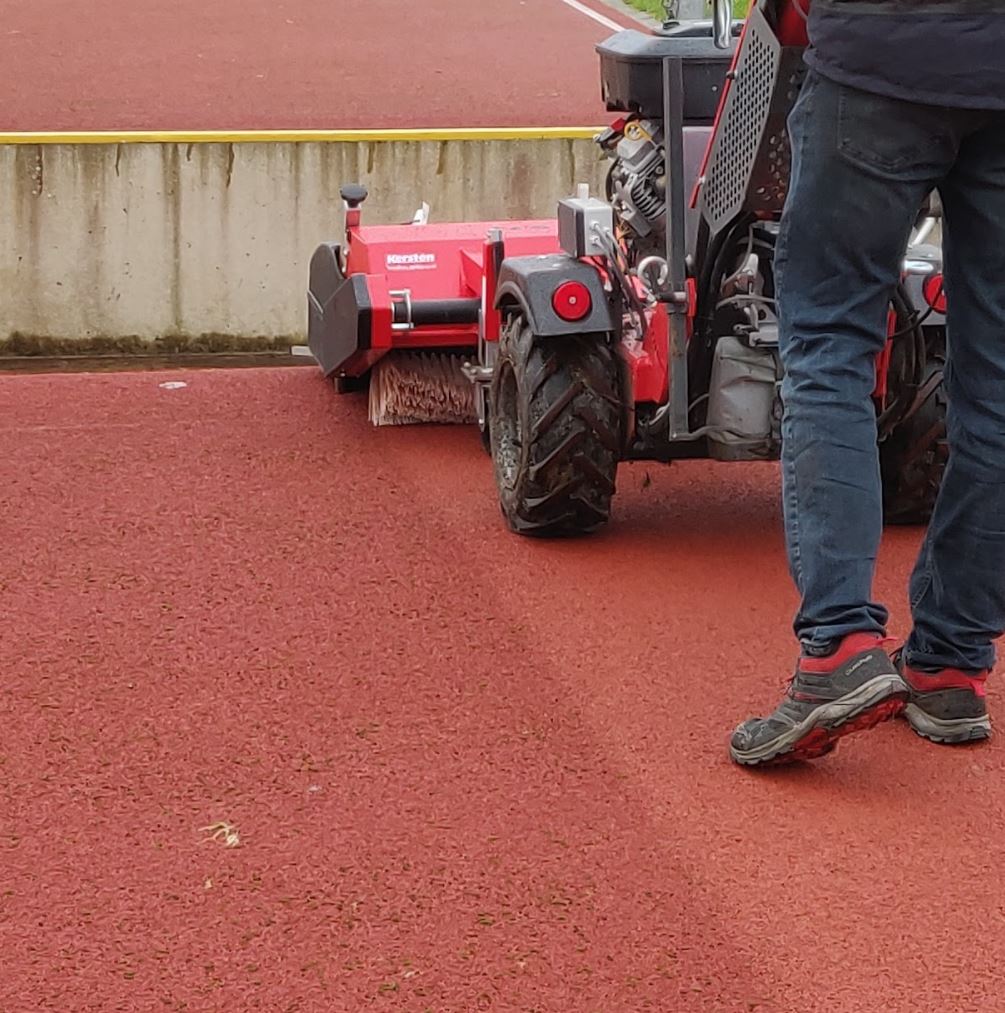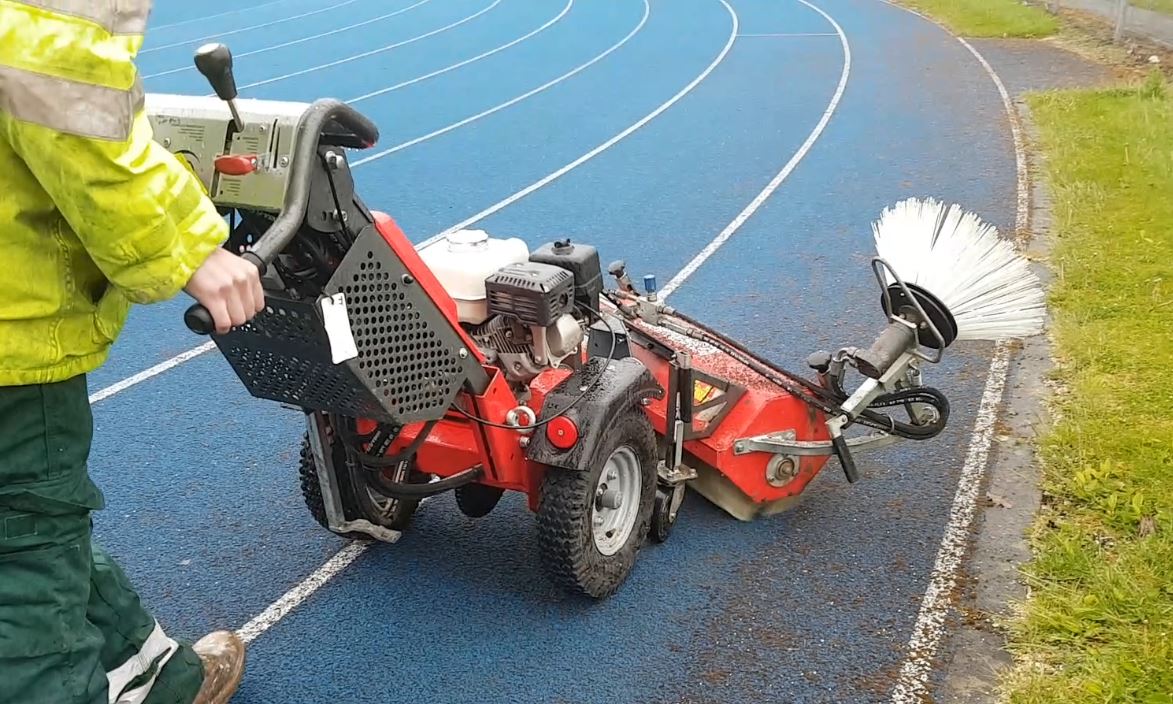Maintaining a Polymeric sports surface
Cleaning and maintaining a Polymeric rubber crumb surface like a running track or tennis court can be tricky but we have some ideas!
Polymeric rubber crumb or EPDM
The SAPCA (Sport and Play Construction Association) code of practice describes the following...
Polymeric tennis courts consist of a permeable foundation of crushed, graded stone, topped with porous asphalt and a playing surface made from a coloured polyurethane binder and rubber crumb or powder, applied directly to the asphalt, or to a polyurethane and rubber cushion layer.
The play-lines are painted on the surface. The resulting surface gives a medium to slow paced game, is free-draining and playable throughout the year, and requires very little maintenance.
Depending on the system used the surface also has a distinctly "cushioned" feel underfoot. The small amount of maintenance required is, nevertheless, very important if the court is to provide a good quality game and is to remain free-draining for its expected lifespan. Indeed, the installer's guarantee is likely to be dependent upon the maintenance recommendations being carried out with reasonable efficiency.
The maintenance procedures are designed to ensure that:
- the playing surface is kept scrupulously clean
- the free drainage of surface water remains unimpaired throughout the life of the court
- moss and algae are not allowed to grow on the surface
- the court looks attractive and well cared for and provides a good surface for playing tennis whenever required
- the court achieves its intended lifespan
These objectives are achieved by:
- sweeping or vacuuming leaves and other detritus from the surface
- occasionally washing the surface
- applying prophylactic treatments of moss-killer and algaecide
The SAPCA code goes on to state ........
Leaves, tree flowers, pine needles, fluff from tennis balls and other detritus should not be allowed to remain on the surface for any length of time. If this does happen they rapidly rot down and settle into the interstices of the surface, impairing drainage and providing a growing medium for algae and moss. A wide soft broom can be used to sweep the surface, but this has a tendency to push smaller material into the surface. A rubber-tined rake is usually better, albeit rather slow and arduous.
Best of all is a mechanical garden vacuum cleaner, which will greatly speed up the operation and do it more efficiently. Mechanical leaf sweepers can also be good. The equipment should be well maintained and carefully operated to avoid contamination of, or physical damage to, the surface. At least once a year the court surface will benefit from a vigorous wash. This not only has the effect of keeping the surface interstices clean and free-draining, but is also essential for maintaining good foothold.
Courts near busy roads are particularly susceptible to becoming coated with “traffic film”, while those near trees may become coated with “honey-dew” from aphids. The resulting black film from either can make the courts very slippery after rain. If the water pressure is reasonably high, washing can be carried out with a domestic hosepipe assisted by a mild cold water detergent. Even more effective are the cold water pressure washers that are available from most equipment hire outlets. These, however, must be used with care, the greatest attention being paid to establishing that the process does not dislodge the coloured surface coating.
A mild, non-foaming detergent increases the efficiency of the operation. Steam cleaners should not be used. If the court surface has become very badly sealed and does not respond satisfactorily to this treatment, the installer or a firm that specialises in cleaning tennis courts should be consulted.
In certain situations, and in some seasons, algae or moss can become established on the court surface. Since prevention is very much more effective than cure, it is important to treat the court with a good proprietary moss killer and algaecide at least once a year. Particular attention should be paid to perimeter and other areas which are not trafficked, especially if they are shaded by walls or buildings or overhung by trees.
Any good proprietary product should be satisfactory provided that it is not oil-based. The manufacturer's instructions should be closely followed. Some installers can supply specially formulated moss-killers. Should moss become established, it should be treated immediately, the application being repeated until the moss can be brushed or vacuumed away. In the case of very severe infestation, the installer should be consulted. It should be emphasised that moss is only a serious problem if it is allowed to become established.
An annual prophylactic application of moss-killer is an easy way of preventing this. Keeping the surface free of vegetable debris on a regular basis renders moss an even less likely problem.
Maintenance schedule
Daily -
- at the end of the day’s play. make sure the net is slackened and rolled up in the middle
- make sure the gate is shut
Weekly -
- clear leaves and rubbish from the court
Monthly -
- deal with any moss or algae
Annually -
- wash the court
- apply moss killer
- call in the installer if any aspect is causing significant concern
Note: These are minimum recommendations. Common sense and careful observation should prevail. If any serious doubt exists about the effectiveness of the maintenance regime or the condition of the court, the installer should be contacted. It is better to be safe than sorry
So ends our text of the SAPCA Code of Practice.

We agree with most of this and especially the statement that prevention is the key.
However we do not agree that moss and algae chemicals are the "go to" solution. Many of the chemicals now available are oil based which should be avoided on the polymeric surface and should certainly not be considered sustainable in the general environment.
Prevention should be reduction of organic material surrounding the surface and able to enter the surface, Removing any material that lands on the surface and ensuring all drainage is understood and well maintained.
If this prevention is carried out then problems will usually be avoided.
We suggest either blowing leaves, dust and detritus off the surface on a regular basis in dry conditions on to an adjoining organic surface where it can safely decompose. Or vacuuming the surface.
Blowing and vacuuming may not remove material which is stuck to or in the surface.
Kersten K series or UBS 2 wheel tractors with our sweeping attachments will sweep and collect the majority of the moss and detritus from the surface which is best carried out on a dry-ish or slightly damp surface. The height of the brush to the ground is finely adjustable to apply just the right amount of pressure to the bristles of the brush.
This process should remove the majority of the material. However due to the porous nature of the surface some material which is below the surface in the interstices may remain.
If you wish to remove more you can use the following process using the same machine but in wet conditions, even very wet conditions!
Without the collection box fitted and using the sweeper at an angle to windrow the material, sweep the surface with a small bow wave of water in front of the brush, This action will tend to gently flood out the crevasses in the surface. The detritus will then float on the wave and deposit on the top of the surface beside the sweeper. several rows may be windrowed in to one and then collected (best when dry).

Kersten supplies many pedestrian and tractor mounted sweepers we believe are suitable for sweeping and cleaning Polymeric sports surfaces.
Site visits can be arranged to enable us to understand individual issues and demonstrate our equipment on your surface.
More details may be found here
https://kerstenuk.com/Kersten-Sweepers-and-Outdoor-Surface-Cleaning
Chris Faulkner
Chris is Managing Director of Kersten UK Ltd Interested in weed control solutions and machinery
No comments yet. Login to start a new discussion Start a new discussion